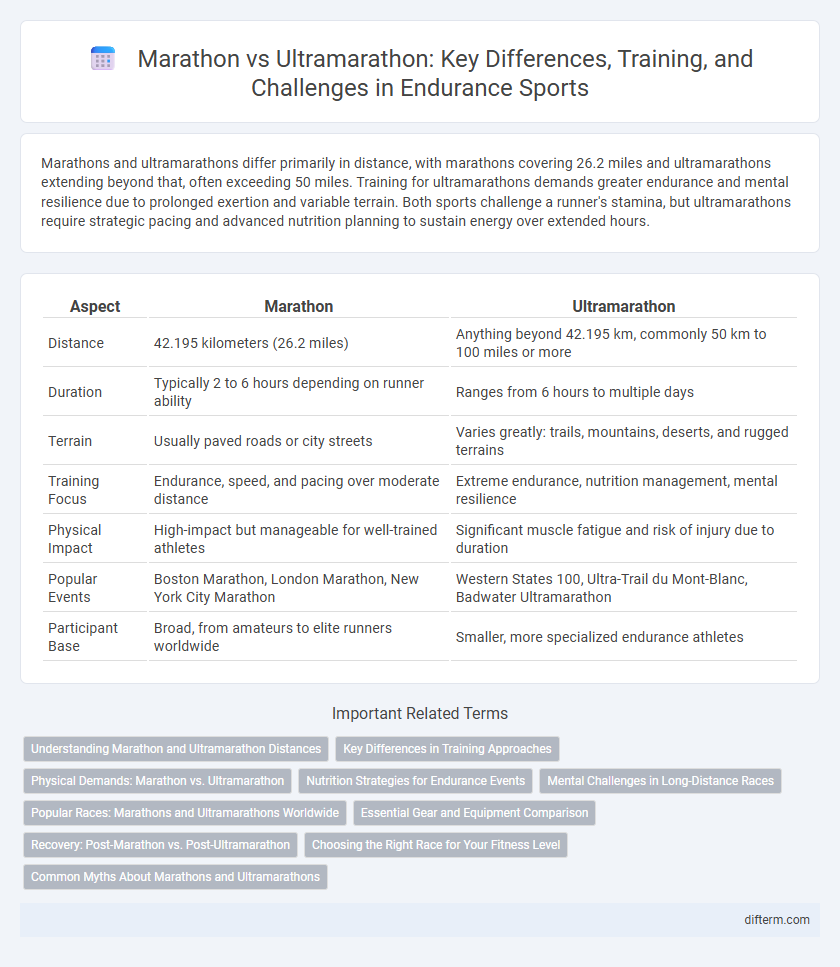Marathons and ultramarathons differ primarily in distance, with marathons covering 26.2 miles and ultramarathons extending beyond that, often exceeding 50 miles. Training for ultramarathons demands greater endurance and mental resilience due to prolonged exertion and variable terrain. Both sports challenge a runner's stamina, but ultramarathons require strategic pacing and advanced nutrition planning to sustain energy over extended hours.
Table of Comparison
| Aspect | Marathon | Ultramarathon |
|---|---|---|
| Distance | 42.195 kilometers (26.2 miles) | Anything beyond 42.195 km, commonly 50 km to 100 miles or more |
| Duration | Typically 2 to 6 hours depending on runner ability | Ranges from 6 hours to multiple days |
| Terrain | Usually paved roads or city streets | Varies greatly: trails, mountains, deserts, and rugged terrains |
| Training Focus | Endurance, speed, and pacing over moderate distance | Extreme endurance, nutrition management, mental resilience |
| Physical Impact | High-impact but manageable for well-trained athletes | Significant muscle fatigue and risk of injury due to duration |
| Popular Events | Boston Marathon, London Marathon, New York City Marathon | Western States 100, Ultra-Trail du Mont-Blanc, Badwater Ultramarathon |
| Participant Base | Broad, from amateurs to elite runners worldwide | Smaller, more specialized endurance athletes |
Understanding Marathon and Ultramarathon Distances
Marathon distances are standardized at 42.195 kilometers (26.2 miles), originating from the ancient Greek story of Pheidippides. Ultramarathons exceed this distance, typically starting at 50 kilometers and extending up to 100 miles or more in various race formats. Understanding these distances helps athletes prepare for the vastly different endurance and training demands between marathons and ultramarathons.
Key Differences in Training Approaches
Marathon training emphasizes consistent mileage with a peak of 40-50 miles per week, focusing on speed intervals, tempo runs, and long runs of 16-22 miles to enhance endurance and pace control. Ultramarathon training involves higher weekly mileage often exceeding 70 miles, prioritizing extended long runs over 30 miles, terrain-specific workouts, and nutrition strategies to sustain energy during prolonged efforts. Recovery protocols differ significantly, with ultramarathoners allocating more time for rest and cross-training to prevent overtraining and injury due to the increased physical and mental demands.
Physical Demands: Marathon vs. Ultramarathon
Marathon races cover 26.2 miles, primarily testing cardiovascular endurance and muscular stamina, whereas ultramarathons exceed this distance, often ranging from 50 kilometers to over 100 miles, demanding extreme physical and mental resilience. The prolonged exertion in ultramarathons leads to greater glycogen depletion, muscle fatigue, and risk of injury compared to marathons. Effective training for ultramarathons includes increased focus on endurance conditioning, nutrition strategies, and recovery protocols to manage the heightened physical demands.
Nutrition Strategies for Endurance Events
Marathon nutrition strategies emphasize carbohydrate loading to maximize glycogen stores, consuming 30-60 grams of carbohydrates per hour during the race, and maintaining hydration with electrolyte-balanced fluids. Ultramarathon fueling requires a more complex approach, including higher calorie intake from carbohydrates, fats, and proteins to sustain prolonged energy demands, along with frequent electrolyte replenishment to prevent hyponatremia and muscle cramps. Runners in both events benefit from personalized nutrition plans that incorporate solid and liquid foods tailored to race duration, intensity, and individual digestive tolerance.
Mental Challenges in Long-Distance Races
Marathon and ultramarathon runners face intense mental challenges, with ultramarathons demanding greater psychological endurance due to longer distances often exceeding 50 kilometers. Mental fatigue, motivation fluctuations, and cognitive endurance play crucial roles in maintaining pace and focus during ultramarathons, surpassing the typical mental strain of a 42.195-kilometer marathon. Effective mental strategies such as visualization, mindfulness, and goal segmentation are essential for overcoming the prolonged psychological stress unique to ultramarathon competitions.
Popular Races: Marathons and Ultramarathons Worldwide
The Boston Marathon, London Marathon, and Berlin Marathon are among the most prestigious and widely participated marathon events globally, attracting elite runners and amateurs alike. Ultramarathons such as the Western States 100, Ultra-Trail du Mont-Blanc (UTMB), and Badwater 135 challenge athletes with extreme distances exceeding 50 kilometers, often on rugged terrain. Both marathon and ultramarathon races foster global communities, pushing endurance limits while showcasing diverse landscapes and cultures.
Essential Gear and Equipment Comparison
Marathon runners typically rely on lightweight, breathable running shoes, moisture-wicking apparel, and hydration belts to maintain comfort and performance over 26.2 miles. Ultramarathon participants require more robust gear including trail-specific shoes with enhanced durability, hydration packs with larger capacity, GPS watches for navigation, and layered clothing suitable for varying weather conditions during extended distances often exceeding 50 miles. Essential equipment for ultramarathons emphasizes durability, versatility, and self-sufficiency to accommodate the challenges of diverse terrain and prolonged exertion.
Recovery: Post-Marathon vs. Post-Ultramarathon
Recovery after a marathon typically involves 1 to 2 weeks of active rest and gradual reintroduction of running to address muscle soreness and glycogen depletion. In contrast, post-ultramarathon recovery requires extended periods, often 3 to 6 weeks, focusing on tissue repair, managing inflammation, and rebuilding endurance due to the extreme physical stress and muscle microtrauma incurred. Nutritional strategies emphasizing protein intake and anti-inflammatory foods play a crucial role in optimizing recovery for both marathon and ultramarathon runners.
Choosing the Right Race for Your Fitness Level
Marathons cover a standardized distance of 26.2 miles, suitable for runners with consistent endurance training and moderate experience. Ultramarathons exceed this distance, often ranging from 50K to 100 miles, demanding advanced stamina, mental resilience, and extensive preparation. Selecting the right race depends on your current fitness level, training commitment, and injury history to ensure a safe and fulfilling running experience.
Common Myths About Marathons and Ultramarathons
Many believe that ultramarathons require drastically different training than marathons, but both demand high endurance and consistent mileage buildup. Another myth is that ultramarathons are only for elite athletes, while in reality, runners of varied experience levels participate in these events. Recovery time after ultramarathons is often exaggerated; proper rest and nutrition can facilitate quicker recovery comparable to marathon training cycles.
marathon vs ultramarathon Infographic

 difterm.com
difterm.com